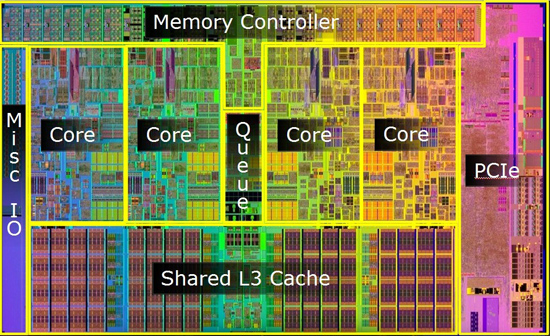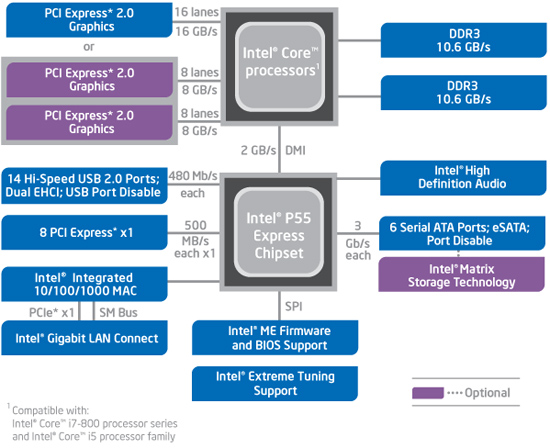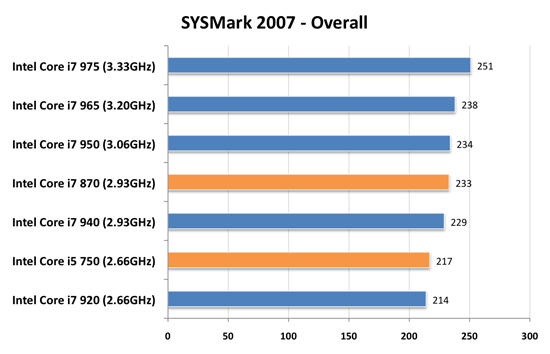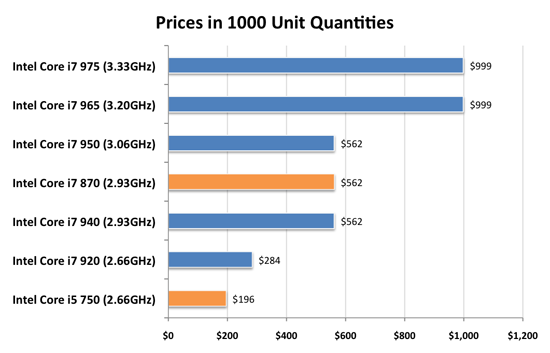Intel's Core i7 870 & i5 750, Lynnfield: Harder, Better, Faster Stronger
by Anand Lal Shimpi on September 8, 2009 12:00 AM EST- Posted in
- CPUs
Intel is on the verge of transitioning to 32nm. We'll see the first parts this year. What do you do with your 45nm fabs when you start moving volume away from them? Make really cheap quad-core Nehalems of course:

I'm talking $196. I'm talking faster than AMD's entire lineup. I'm talking about arguably the best processor of 2009. I'm talking about Lynnfield, and here's its backside:

Mmm
I spent much of the past year harping on AMD selling Nehalem-sized Phenom IIs for less than Intel sold Nehalems. With Lynnfield, Intel actually made Nehalem even bigger all while driving prices down. Like I said, what do you do when you're still making boatloads of money in a recession and are about to start emptying your 45nm fabs?
I should clear things up before we progress much further. Lynnfield is the codename for mainstream 45nm quad-core Nehalem, while Bloomfield refers to the first Nehalem launched at the end of 2008:
| Processor | Manufacturing Process | Die Size | Transistor Count | Socket |
| Bloomfield | 45nm | 263 mm2 | 731M | LGA-1366 |
| Lynnfield | 45nm | 296 mm2 | 774M | LGA-1156 |
Despite being cheaper, Lynnfield is larger than Bloomfield. The larger die is due to one major addition: an on-die PCIe controller.

Bloomfield, The First Nehalem, circa 2008

Lynnfield, Nehalem for All, circa 2009
The pink block to the right of the die is the PCIe controller, that's 16 PCIe 2.0 lanes coming right off the chip. Say hello to ultra low latency GPU communication. You'd think that Intel was about to enter the graphics market or something with a design like this.
Sacrifices were made to reduce CPU, socket and board complexity. Gone are the two QPI links that each provided 25.6GB/s of bandwidth to other CPUs or chips on the motherboard. We also lose one of the three 64-bit DDR3 memory channels, Lynnfield only has two like a normal processor (silly overachieving Bloomfield).

Intel's Bloomfield Platform (X58 + LGA-1366)
The sum is that Lynnfield is exclusively single-socket; there will be no LGA-1156 Skulltrail. While the dual-channel memory controller isn't really a limitation for quad-core parts, six and eight core designs may be better suited for LGA-1366.

Intel's Lynnfield Platform (P55 + LGA-1156)
The loss of QPI means that Lynnfield doesn't have a super fast connection to the rest of the system, but with an on-die PCIe controller it doesn't matter: the GPU is fed right off the CPU.
The Lineup
We get three Lynnfield CPUs today: the Core i7 870, Core i7 860 and the Core i5 750. Intel's branding folks told us that the naming would make sense one we saw the rest of the "Core" parts introduced; yeah that was pretty much a lie. At least there aren't any overlapping part numbers (e.g. Core i5 860 and Core i7 860).
The i7 in this case denotes four cores + Hyper Threading, the i5 means four cores but no Hyper Threading. The rules get more complicated as you bring notebooks into the fray but let's momentarily bask in marginal simplicity.
| Processor | Clock Speed | Cores / Threads | Maximum Single Core Turbo Frequency | TDP | Price |
| Intel Core i7-975 Extreme | 3.33GHz | 4 / 8 | 3.60GHz | 130W | $999 |
| Intel Core i7 965 Extreme | 3.20GHz | 4 / 8 | 3.46GHz | 130W | $999 |
| Intel Core i7 940 | 2.93GHz | 4 / 8 | 3.20GHz | 130W | $562 |
| Intel Core i7 920 | 2.66GHz | 4 / 8 | 2.93GHz | 130W | $284 |
| Intel Core i7 870 | 2.93GHz | 4 / 8 | 3.60GHz | 95W | $562 |
| Intel Core i7 860 | 2.80GHz | 4 / 8 | 3.46GHz | 95W | $284 |
| Intel Core i5 750 | 2.66GHz | 4 / 4 | 3.20GHz | 95W | $196 |
Keeping Hyper Threading off of the Core i5 is purely done to limit performance. There aren't any yield reasons why HT couldn't be enabled.
Intel was very careful with both pricing and performance of its Lynnfield processors. I'm going to go ahead and say it right now, there's no need for any LGA-1366 processors slower than a Core i7 965:

This is only one benchmark, but it's representative of what you're about to see. The Core i7 870 (LGA-1156) is as fast, if not faster, than every single LGA-1366 processor except for the ones that cost $999. Its pricing is competitive as well:

For $196 you're getting a processor that's faster than the Core i7 920. I'm not taking into account motherboard prices either, which are anywhere from $50 - $100 cheaper for LGA-1156 boards. I don't believe LGA-1366 is dead, but there's absolutely no reason to buy anything slower than a 965 if you're going that route.










343 Comments
View All Comments
mschira - Tuesday, September 8, 2009 - link
I wonder if a 4xPCIe RAID adapter directly connected to a PCIe slot that is connected to the CPU is any faster than it is for a Core i7 920....Cheers
Gary Key - Tuesday, September 8, 2009 - link
Less than a one percent difference in my testing so far.Jamahl - Tuesday, September 8, 2009 - link
Why do your benches falsely state 2.66ghz when they are clearly running faster than that?rbbot - Tuesday, September 8, 2009 - link
lol - I've just been berating a reviewer on another site for benchmarking with turbo off! In that case the review wasn't targeted at an overclocking audience, but even here I can't see the argument for benchmarking with it disabled.Yes you do need to turn it off for extreme overclocking, but this review is comparing the chips in their stock configuration and stock configuration is on.
maxxcool - Tuesday, September 8, 2009 - link
As for false, well gee, you were told it was on. Didn't you read that? or are you snakeoils brother?goinginstyle - Tuesday, September 8, 2009 - link
They list the base CPU speeds, it was discussed clearly in the article that turbo is enabled, it is not a false statement for reporting what you will purchase. Apparently you just want to flame bait here and I hope they ban you and the two other nut jobs.rgallant - Wednesday, September 9, 2009 - link
people see what they want to see I guess-I wanted to see the multi gpu test, 1156 vs 1366 , clock vs clock ,fps vs fps ,16x vs 8x on die , not one chip overclocking it's self unless you show the numbers for turbo on and off, what if the 1366 mb used for the benches came out of the box and by the default bios overclocked the i7 920 to 3.8 ,would those numbers be included as stock out of the box. I don't think so , that feature would be turned off on the mb.for the benches. 1156 numbers could mean nothing really.
-all cpu's should been locked at 3.6 at least for the multi gpu test or one test anyways.
-the 8x 8x lane issue is the only crippled feature on the new chips ,and it seems to take a back seat to the $50.00 savings for a mb for a $600.00 i7 870 chip ,or $900.00 CND .lol On sept.05 my local shop had the i7 920 D0 and the i7 860 both at $345 CND.
-good review as always ,just missing that part for me , looking to commit on a 1156 or a 1366 upgrade.
maxxcool - Tuesday, September 8, 2009 - link
Yeah, you got to get rid of snakeoil, he is quiet the troll on the TechReport forums as well. He has been banned from several sites already.andrenb91 - Tuesday, September 8, 2009 - link
i5 is faster than PII's! but gotta wait for the lower end ones come outbecause these $190+ chips aren't the one ones that brings up revenue for companies like amd or intel...of course intel has the upper hand here, it could use as a propaganda do deliver up the slower parts. Amd has value and some good cpus at the lower end... that ones bring profits to the company,amd strategy is looking good for now, but it's design must change (native dual/tripe core versions of Phenom II) and the die size have to get smaller to compete next year (against 32nm low end ones...) well I use amd budget ones, for what I do is good enough, ( thin about $400 pc in USA, live in Brazil...) still, I can play some 40fps games and do some video encoding with my gpu,my point is, amd still have the lower-end market, the problem is, if were some of that people that think pentium is a company name, I would by the pentium cpus instead of amd strange cpus. that's why intel sells a lot more desktops and notebooks, of course the performace is great at some 700+ pcs and laptops, but amd has the lower-end, and there it is what amd is looking for: market share, and taht will pump amd back again by 2011 with its fusion apu, intel already controls 80% of mainstream,and high-end markets, but doesn't have a player for the lower-end, thats what I'm looking for a good old intel cpu that beats p2x3 or athlonIIx4 by intel at about $100. then I'll buy my next cpu, probably an intel, or continue with Amd, time will tell...
andrenb91 - Tuesday, September 8, 2009 - link
sorry for my english and, these benchmarks are for windows only, over linux intel i5 will not have this crazy advantage at all, well but who of us uses linux anyway?(don't lie to me, it's a dual boot...) well my system specs are: phenomII x3 705e,4gb ddr3 1333,hd 4650 basicaly a low-end to mainstream..